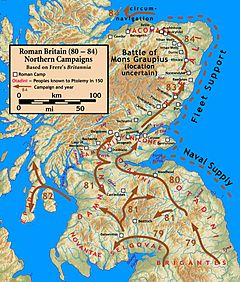Battle of Mons Graupius facts for kids
Quick facts for kids Battle of Mons Graupius |
|||||||
|---|---|---|---|---|---|---|---|
| Part of Roman conquest of Britain | |||||||
 |
|||||||
|
|||||||
| Belligerents | |||||||
| Roman Empire | Caledonian Confederacy | ||||||
| Commanders and leaders | |||||||
| Agricola | Calgacus | ||||||
| Strength | |||||||
| 17,000-30,000+ | 15,000-30,000+ | ||||||
| Casualties and losses | |||||||
| 360 dead | 10,000 dead | ||||||
The Battle of Mons Graupius was a big fight between the Romans and the native people of Scotland. It happened around 83 or 84 AD. This battle was a major victory for the Romans, according to a Roman historian named Tacitus. However, exactly where this battle took place is still a mystery today. Some historians even wonder if Tacitus made the Roman success sound bigger than it was.
Contents
Why Did the Battle of Mons Graupius Happen?
Tacitus was the son-in-law of Gnaeus Julius Agricola. Agricola was the Roman governor in charge of Britain. He sent his ships ahead to scare the Caledonians. Then, he marched his army, which included light soldiers and helpers from Britain, to the battle site. He found the enemy already waiting there.
The Romans often found it hard to get the British tribes to fight them in a big, open battle. The Caledonians were the last major tribe in Britain that the Romans hadn't fully conquered. They had avoided fighting for many years. But this time, they had no choice. The Romans marched towards the Caledonians' main granaries (places where they stored grain). These granaries were full after the harvest. The Caledonians had to fight, or they would starve during the winter.
Where Was the Battle of Mons Graupius Fought?
The exact spot of the Battle of Mons Graupius has been debated for a long time. In the 1800s, people thought it was near many Roman sites in Perth and Kinross. Later, with new ways of finding old sites like aerial photography, the focus shifted. Many now believe the battle happened in north-east Scotland, possibly in Aberdeenshire.
One popular idea is that the battle took place near Bennachie. This is a very noticeable hill south of a large Roman camp called Logie Durno. Other places suggested include Kempstone Hill or Megray Hill. These areas are close to an old path called the Elsick Mounth. Both Romans and Caledonians used this path for moving their armies.
Archaeologists have found Roman items in these suggested areas. This shows that Romans were definitely there. However, because the exact location is still unknown, it's not officially listed as a historic battlefield in Scotland.
How Did the Battle of Mons Graupius Unfold?
Tacitus tells us that the Roman army had about 8,000 helper soldiers (called auxiliaries) in the middle. They also had 3,000 cavalry (soldiers on horseback) on the sides. The main Roman soldiers (legionaries) stayed in reserve behind them. The total Roman army might have been 17,000 to 30,000 strong.
The Caledonian army, led by a chief named Calgacus, was said to be over 30,000 strong. They were mostly positioned on higher ground. Their front lines were on flat land, but the rest of their soldiers were stacked up the hill in a horseshoe shape. Caledonian chariots (horse-drawn carts with fighters) moved around on the flat ground between the two armies.
After a short exchange of thrown weapons, Agricola ordered his helper soldiers to attack. These included brave fighters from tribes like the Batavians and Tungri. They charged forward. The Caledonians on the lower parts of the hill were quickly defeated. Some Caledonians tried to go around the Roman army, but the Roman cavalry outsmarted them.
The Caledonians were completely beaten and ran into the nearby woods. But the organized Roman soldiers chased them. Tacitus claims that the main Roman legions didn't even need to fight. They stayed in reserve the whole time. He also said that 10,000 Caledonians died, but only 360 Roman helper soldiers were lost. The remaining 20,000 Caledonians escaped into the woods. Roman scouts couldn't find them the next morning.
Were Tacitus's Battle Accounts Accurate?
Some historians have questioned if Tacitus's report of such a big Roman victory was entirely true. One idea is that the Roman emperor, Domitian, might have found out that Agricola's claims were exaggerated.
However, Agricola was given special honors when he returned to Rome. He was even offered another important job in a different part of the empire. This makes it seem unlikely that Emperor Domitian doubted Agricola's success. It's probably not true that Agricola made up the whole story and was then ignored by the emperor.
What Happened After the Battle of Mons Graupius?
After this battle, it was announced that Agricola had finally brought all the tribes of Britain under Roman control. Soon after, he was called back to Rome. Another governor, Sallustius Lucullus, took his place.
It's likely that Rome wanted to keep fighting and conquer all of Britain. But the Roman Empire needed its soldiers elsewhere. So, troops were pulled out, and the chance to fully conquer Britain was lost. Tacitus was disappointed by this. He wrote that Britain was "completely conquered and immediately let go." This showed his strong disapproval of Emperor Domitian's decision not to unite the whole island under Roman rule after Agricola's successful campaign.
See also

